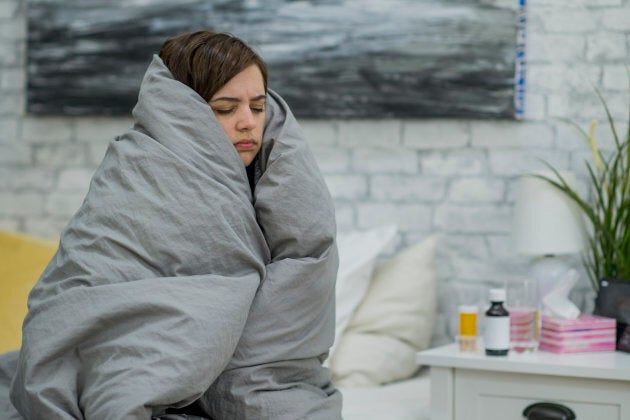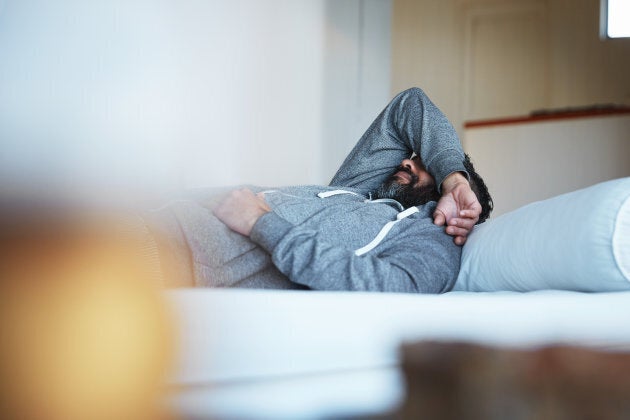Winter — i.e. cold and flu season — is here. It seems as if everyone around me is fighting something. The question of the moment being "Do I soldier on and work out when sick... or do I rest?"
Answer: being sick is often a valid reason to take it easy, but don't conflate "easy" with "complete inactivity." Not all motion is created equal. There is a huge range of activity options between gentle movement or stretching and purposefully working out.

Immune health 101
Low to moderate intensity activity positively affects immune health. Intense or prolonged workouts can decrease immune resilience for up to 72 hours, which — when you are healthy and given appropriate recovery tools such as sleep and a nutritious diet — is a good thing. The body adapts to the stress of an intense workout. Over time this progressive adaptation makes you — and your immune system — stronger.
When sick, the stress of an intense workout is no longer a positive stimulus. The body does not have the capacity to adapt and become stronger. Avoid activity vigorous enough to further stress the body, but that doesn't mean "do nothing." Purposeful breathing, stretching and low to moderate intensity workouts such as walking — in proportion to your symptoms — can help, not hinder, your recovery.
Skip formal exercise in favour of practicing purposeful breathing, gentle stretching and dynamic mobility exercises.
General guidelines
With symptoms above the neck, move. Just keep the intensity moderate, keep the duration short and obviously stop if you begin to feel worse. Moderate motion will improve your mood, will decrease stiffness and might even improve recovery time. Chose activities that don't zap your energy; walk, garden or try some tai chi or yoga.
With the flu or below-the-neck symptoms, skip formal exercise in favour of practicing purposeful breathing, gentle stretching and dynamic mobility exercises.
Obviously, keep in mind how sick you are. Don't wake yourself up to do deep breathing, but when you do wake, try a few of the exercises below. Why? Purposeful breathing regulates your nervous system and blood chemistry, which will help to decrease aches and pains. Moving (even gently) improves circulation and helps to regulate your lymphatic system — the one-way drainage system that picks up excess tissue fluid called lymph. Lymph drainage is an important aspect of immune recovery and is aided by pressure changes elicited during breathing and the "milking action" that occurs through activating muscles. Plus, existing in one position results in aches and stiffness, and extra body discomfort is the last thing you need when you are sick.

"I am in bed all day" exercises
Aim for an intensity oftwo out of 10.
Diaphragmatic breaths:Place one hand on your upper chest. Breathe into your diaphragm, expanding the air equally into your sides and stomach. Your stomach should rise slightly, but the hand on your chest should not, and your neck should not contract or tighten. Imagine an expanding umbrella: aim for your midsection to expand in three directions like a well-functioning umbrella — not like a wind-beaten umbrella only expanding in one direction. Practice breathing on the sofa, in bed or while walking around your home.
Ankle and hand rotations: Rotate your ankles and wrists 10 times in each direction.
Arm bone and thigh bone rotation: Lie on your back, arms by your side. First, rotate your thigh bones so your feet flop in and out. Then, rotate your arm bones so your hands flop toward and away from you. Finally, put the two together. Arm bones rotate out as thigh bones rotate in.
Knee to chest: Lie on your back and pull one knee to your chest for 30 seconds. Switch and repeat.
Heel/arm reach: Lie on your back, legs straight. Reach your heels long while simultaneously reaching your arms over your head. Hold for 10 seconds.

"I am feeling slightly better but still at home" exercises
Hip-flexor stretch: Step your right leg behind you, both feet facing forward, knees slightly bent. Tuck your pelvis so your right hip bones move toward your ribs. Feel a stretch up the front of your right thigh. Hold for 30 seconds. Switch legs.
Standing calf stretch: Stand on a step with the ball of your right foot on the edge. Let your right heel fall toward the ground. Hold for 30 seconds. Switch legs.
Hip strengthener:Lie on your side, hips stacked and legs long. Engage your bum muscle to lift your top leg up 15 times.
Thigh strengthener: Lie on your back with a pillow under one knee. Straighten your leg so the back of your knee pushes gently into the pillow. Repeat 15 times
Shoulder/arm rotations: Stand. Roll your shoulders backward once. Then, circle your entire arm backward once. Repeat both three times. Feel your shoulder blades move through both.
Final thought
Improved immune health requires consistent, moderate motion. You don't need to spend hours at the gym to positively affect your immune system — or mood, blood sugar levels or energy for that matter. You just have to do something. Make daily motion a non-negotiable. Something is always better than nothing, so never skip an opportunity to move.
Follow HuffPost Canada Blogs on Facebook
Also on HuffPost: